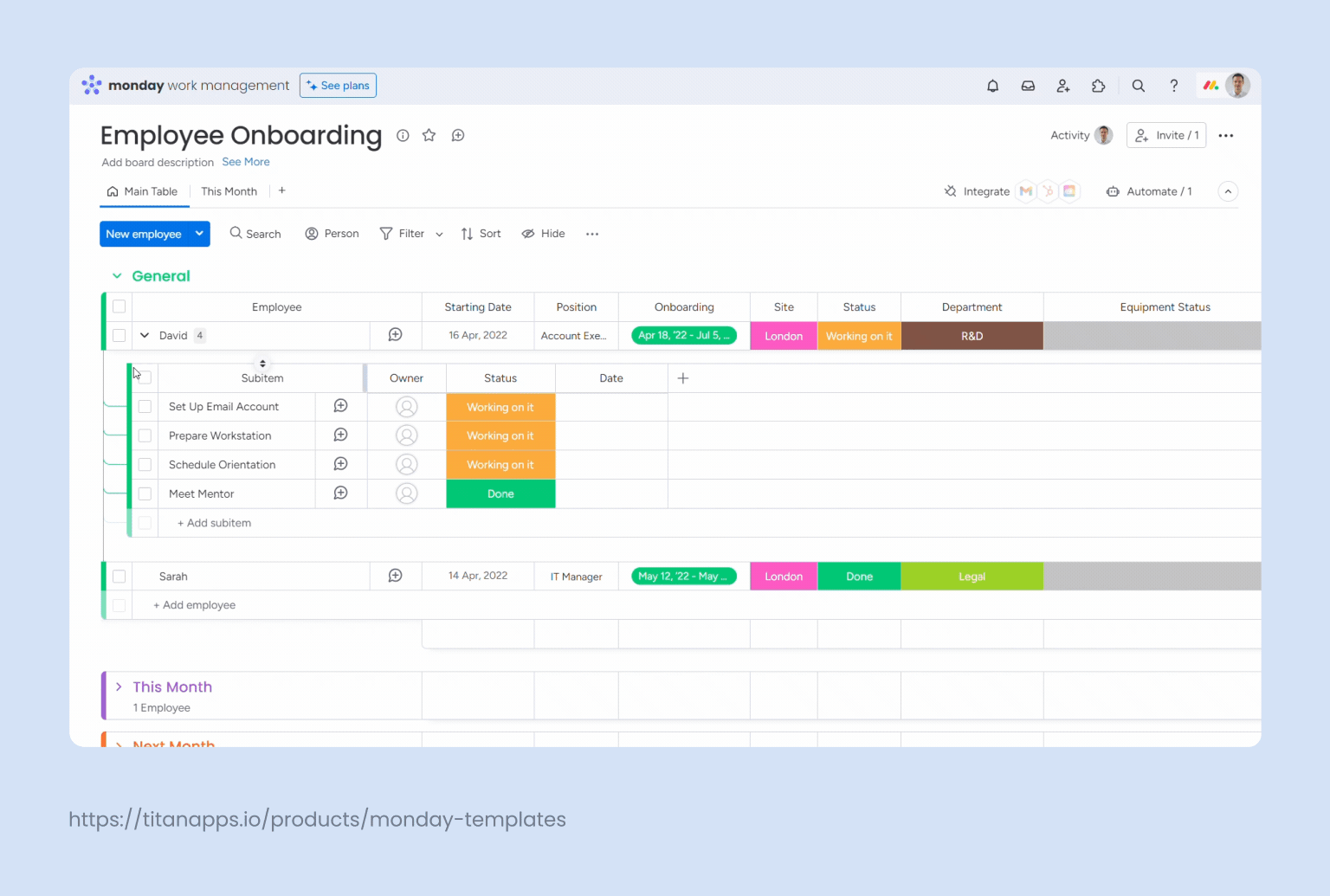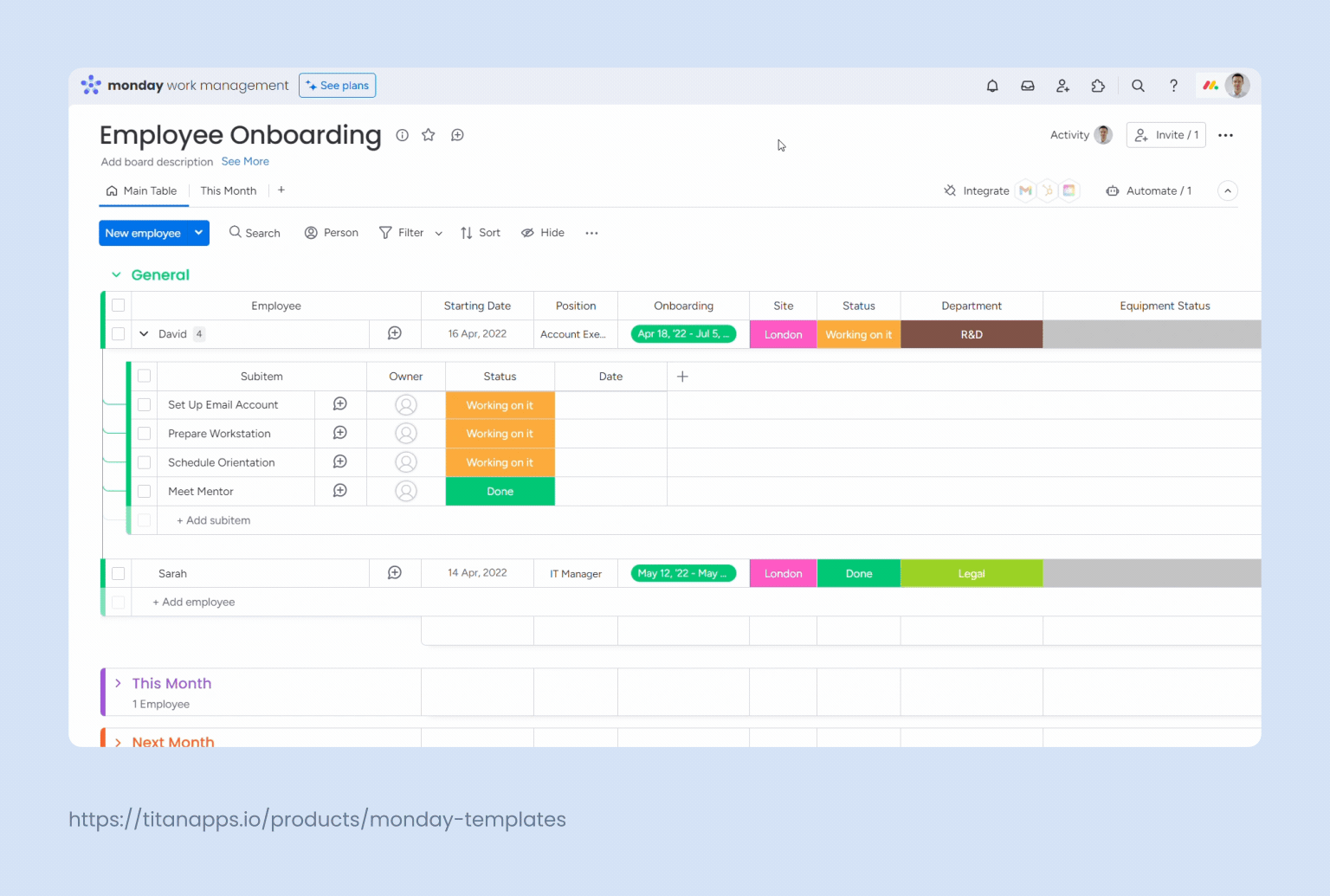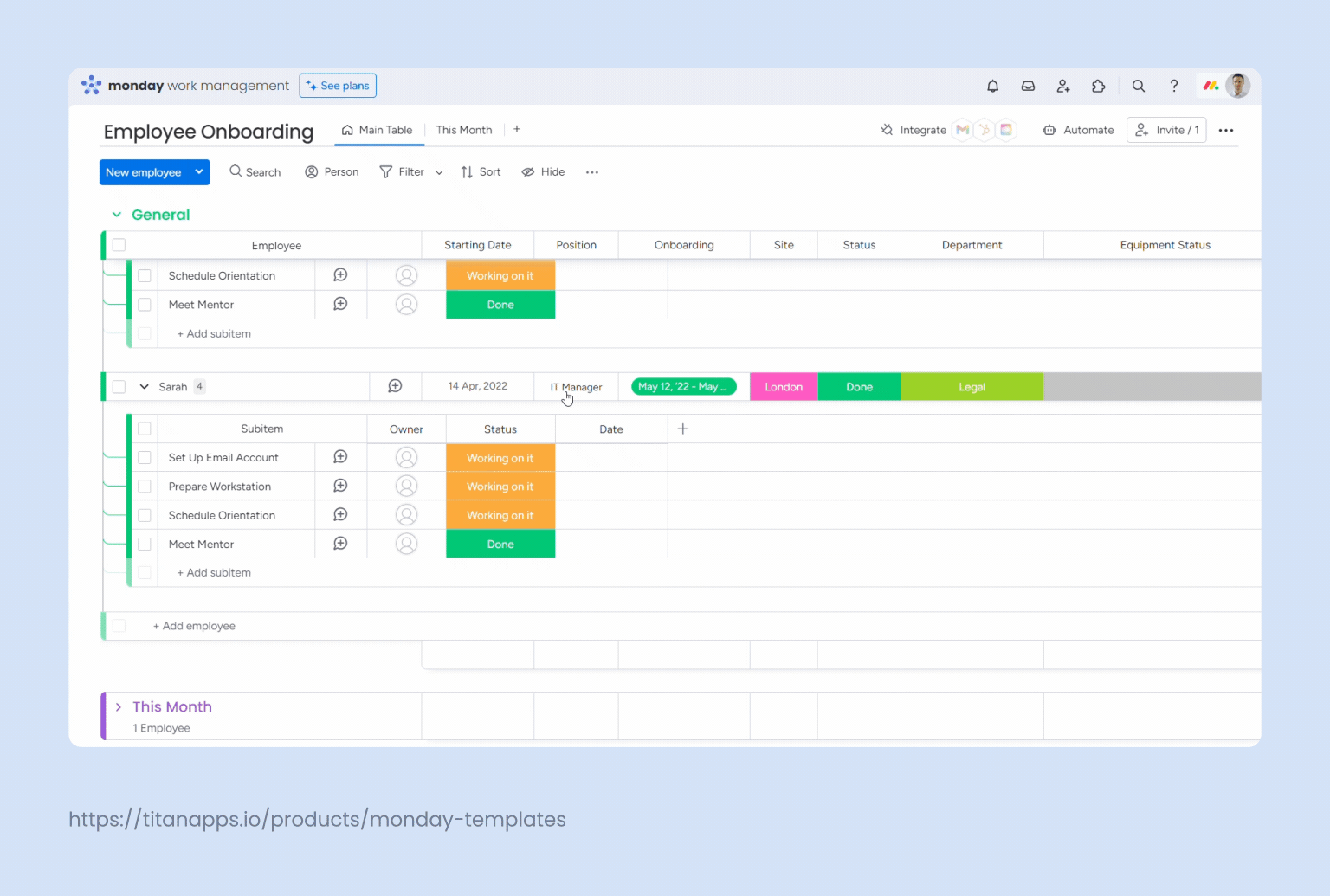When you have recurring tasks or multiple projects with similar structures, recreating the same subitems on monday.com for every new task is truly dreadful. Well, “dreadful” might be an exaggeration, but it’s definitely annoying and time-consuming.
That’s why I’ve created this article to help you enhance your workflow efficiency by templating and automating processes.
What are subitems in monday.com?
On monday.com, workspaces are structured into boards, groups, items, and subitems, allowing teams to organize and manage their tasks. Boards serve as components within a workspace, where groups of items are categorized to represent different stages of a project. Items are usually entries within these groups, and subitems are the smaller detailed subtasks that fall under an item.
For example, imagine an HR manager handling the onboarding process for new employees. They have a board called “Employee Onboarding” that features a few groups. The first group is called “Current month” and has an employee, Dave, set as an “item” with columns like “Starting Date,” “Position,” “Onboarding,” “Site,” “Status,” “Department,” and so on.

Under the item, tasks like “Set Up Email Account,” “Prepare Workstation,” “Schedule Orientation,” and “Meet Mentor” are listed as subitems.
But here’s where things get tricky: every time a new hire is onboarded, the HR manager needs to recreate all of these subitems from scratch.
monday.com has a wide range of features for managing your boards and template workflows, but it lacks functionality for saving items or subitems as reusable templates. This takes up a lot of precious time and leads to repetitive manual work and, of course, potential errors, especially with tasks that frequently recur across different projects.
The good news is that there is an easy and effective solution to this problem – Smart Templates.
Smart Templates allow you to save and reuse items and subitems, making it easy to replicate detailed task structures.
How to create and manage subitem templates in monday.com?
Smart Templates can be installed directly from your monday.com board or through monday’s App Marketplace. Once installed, you can save groups, items, or subitems as templates in various combinations, enhancing your project management workflow efficiency.
To see how this works in practice, let’s revisit our HR manager example who is onboarding the new employee Dave. After setting up Dave’s onboarding tasks under the “Current month” group, this structure can be saved as a template.
Simply select all the relevant subitems, navigate to “Apps,” choose “Save as Smart Template”, and give it a name.

Next time the HR manager needs to onboard a new employee, they just need to go to the “Employee Onboarding” board, add a new item to the relevant group, open the Smart Templates view, and use the saved “First Day Tasks” template.

Smart Templates allow you to save, customize, and edit your templates. For instance, if the HR manager decides to add a new task (like “Introduction to Team Tools”), it can easily be added to the template.
By default, Smart Templates save subitem columns with the data in them, but you can also add new columns or modify existing ones. Furthermore, the column mapping feature helps to use templates on multiple boards, even if they have different sets of columns.
For example, let’s say the HR manager’s onboarding template has a column “Trial Period End Date.” Another HR team uses a different board with a column called “Trial ends,” and they want to reuse the same template that the first team uses. Mapping “Trial Period End Date” to “Trial ends” helps to accurately track important events across boards and stay consistent.
While I’m giving the HR onboarding use case here, Smart Templates can be applied to any situation.
Whether you are managing a marketing campaign, planning a product update, or tracking a complex financial project, Smart Templates provide the flexibility to save and reuse detailed task structures in various combinations, making your life easier.
How to automate monday.com subitem templates?
Having a template for recurring tasks is great. However, keeping track of these tasks and applying a template each time is still time-consuming. For example, if you’re preparing a monthly financial report, it requires setting up the same items/subitems each time on a particular date.
But as I mentioned earlier, there is always a solution. On monday.com, that solution is called “recipes.” These are simple rules that help you automate your actions in monday.com, like creating or updating items/subitems automatically.
To set one up, navigate to the automation center by clicking “Automate” in the upper right corner of a workspace and click the “Board automation” tab. Here, you can set all the triggers.
These triggers include status changes, specific dates, item creation, team member assignments, and more. The number of automation combinations is extensive, allowing you to customize processes and ensure everything runs smoothly.
The best part is that Smart Templates easily integrate with monday’s automation tools.
Let’s check on our HR manager again, who is already using Smart Templates to streamline the onboarding process. However, even with the template, they must manually apply it every time a new employee is onboarded.
To automate this, the HR manager sets up a trigger that automatically uses the “First Day Tasks” template whenever a new item is created in the “Current month” group of the “Employee Onboarding” board, thus removing the manual steps.

This is just a basic automation. It can go further with things like automatically assigning a mentor to each new hire, sending notifications to other board members, and so on. By using these automations in combination with Smart Templates, you can significantly reduce manual workload and avoid forgetting to complete important tasks.
The best workflows are the ones that fit your and your team’s needs. But efficiency is always desired in any process — and this is precisely what you can achieve with Smart Templates. Customize, automate, and template your workflows, and save valuable time while ensuring that nothing falls through the cracks.